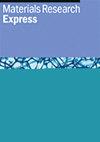An experimental study on material removal rate and surface roughness of Cu-Al-Mn ternary shape memory alloys using CNC end milling
IF 2.2
4区 材料科学
Q3 MATERIALS SCIENCE, MULTIDISCIPLINARY
引用次数: 0
Abstract
This study investigates the impact of Computer Numerical Control (CNC) milling parameters on Cu-Al-Mn SMAs (Shape memory alloys) to evaluate the effects on Surface Roughness (SR) and Material Removal Rate (MRR). The primary variables examined comprise of cutting speed, feed rate, and depth of cut. Results indicate that the Shape Memory Effect (SME) is higher in Copper Aluminium Manganese (CAM 3) compared to CAM 1 and CAM 2, with SME improving from 3.5% to 5.5% as Manganese (Mn) content increases, reflecting an increase in dislocations within the metal’s crystal structure. Surface roughness increases with higher feed rates and depths of cut but decreases with increased cutting speed. MRR shows a positive correlation with feed rate, depth of cut, and cutting speed, though it decreases with higher Mn content. Notably, CAM 3 exhibits lower MRR compared to CAM 1 and CAM 2. Scanning Electron Microscopy (SEM) reveals that at lower feed rates (0.10 mm rev−1), the surface is smooth and free of ridges or feed marks, while at higher feed rates (0.18 mm rev−1), noticeable surface imperfections and plastic deformation occur. The addition of Mn improves surface smoothness and machinability, it also affects MRR. Further suggesting that Mn content and milling parameters significantly influence both the mechanical properties and machinability of Cu-Al-Mn SMAs respectively.使用数控端铣加工铜-铝-锰三元形状记忆合金的材料去除率和表面粗糙度的实验研究
本研究调查了计算机数控(CNC)铣削参数对铜-铝-锰 SMA(形状记忆合金)的影响,以评估其对表面粗糙度(SR)和材料去除率(MRR)的影响。研究的主要变量包括切削速度、进给量和切削深度。结果表明,与 CAM 1 和 CAM 2 相比,铜铝锰(CAM 3)的形状记忆效应(SME)更高,随着锰(Mn)含量的增加,SME 从 3.5% 提高到 5.5%,这反映了金属晶体结构中位错的增加。表面粗糙度随着进给率和切削深度的增加而增加,但随着切削速度的增加而降低。MRR 与进给率、切削深度和切削速度呈正相关,但随着锰含量的增加而降低。值得注意的是,与 CAM 1 和 CAM 2 相比,CAM 3 的 MRR 更低。扫描电子显微镜(SEM)显示,在较低的进给速度(0.10 mm rev-1)下,表面光滑且无脊或进给痕迹,而在较高的进给速度(0.18 mm rev-1)下,则会出现明显的表面缺陷和塑性变形。锰的添加改善了表面光滑度和可加工性,但也影响了 MRR。这进一步表明,锰含量和铣削参数分别对铜-铝-锰 SMA 的机械性能和可加工性有重大影响。
本文章由计算机程序翻译,如有差异,请以英文原文为准。
求助全文
约1分钟内获得全文
求助全文
来源期刊

Materials Research Express
MATERIALS SCIENCE, MULTIDISCIPLINARY-
CiteScore
4.50
自引率
4.30%
发文量
640
审稿时长
12 weeks
期刊介绍:
A broad, rapid peer-review journal publishing new experimental and theoretical research on the design, fabrication, properties and applications of all classes of materials.
 求助内容:
求助内容: 应助结果提醒方式:
应助结果提醒方式:


